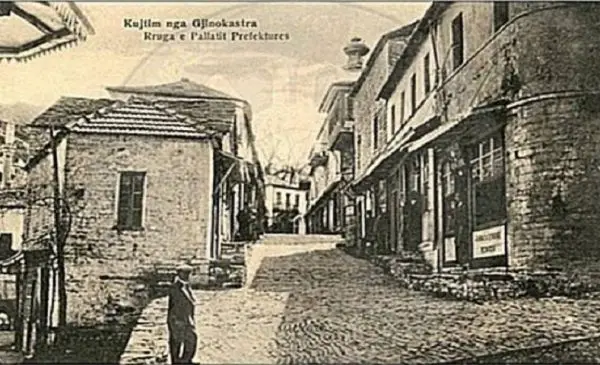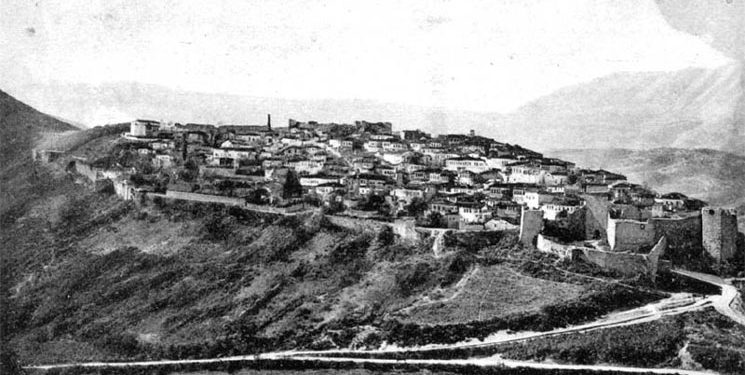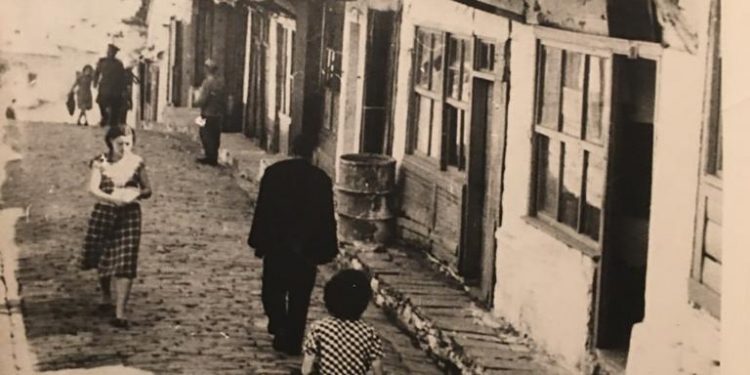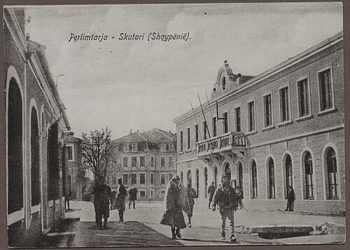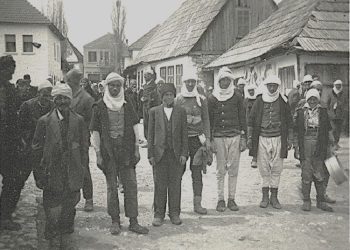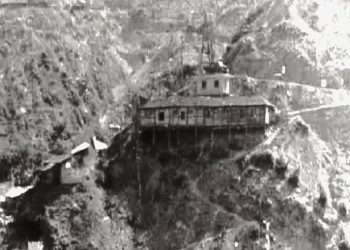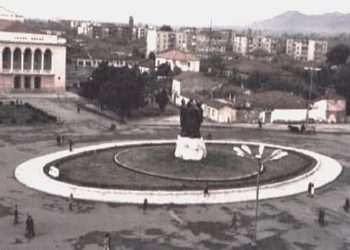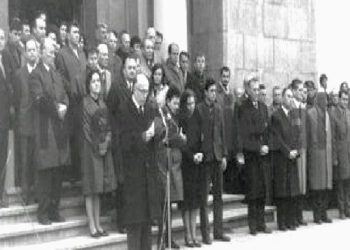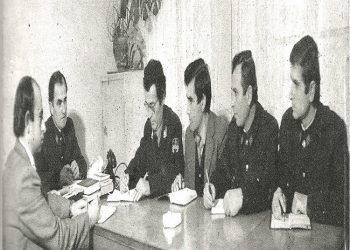Dashnor Kaloçi
Memorie.al publishes the unknown story of the Romanian journalist, Dr. Vlad Vanteanu, who in 1934, undertook a long journey through Albania, visiting almost all the main cities of our country. How he was amazed by the fabulous beauties of Berat and Gjirokastra and the reports he made in the newspaper “Cuvantul” of Bucharest about those two cities that he compared to Monaco and Ragusa!
Its ancient history and the great men it brought forth over the centuries, so masterfully described by foreign chroniclers as Evla Celebi, then Pukvili and Byron, or the fabulous beauties of many picturesque cities and its provinces from south to north, magnificent millennial forts, magnificent and generous people with their characteristic costumes, and who knows what else he had heard about the Albanian country, pushed the Romanian journalist Vlad Vanteanu, in 1934, to undertake a journey to long in all the provinces and cities of Albania. And then fascinated by what he saw, to write some reports in the newspaper “Cuvantul” of Bucharest where he worked. From those impressions and masterfully cast in his reports, we have selected for publication those where he talks about Berat and Gjirokastra, which we are publishing in full and without any cuts, in the original version as they were translated and published in full 86 years ago, in the newspaper “Besa” of Tirana, with owner and publisher, Fiqri Rusin.
Romanian journalist’s report: “Berat, Pearl of central Albania”
One of the most beautiful cities in Albania, with special Albanian views as well as Gjinokastra in the southeast, is Berat. The position of these two cities is one of the most picturesque. Berat is located at the foot of the Tomorri Mountains, which is the highest in Central Albania and has an altitude of over 2,500 meters. It is the Albanian Olympus with legendary gods in which hundreds of Christians and Muslims walked in the summer. This is the foundation of the city which in the east is dominated by Mount Sinia, from about 1,200 meters high, while on the other side it is surrounded by high hills that reach almost 1000 meters. In this district lies Berat, not on the slope of the river Osum which has become a place inside the hills, but on both sides of the mountains that surround the river. A position that could not be more beautiful. Not securing the early old times wanted cities to leave the fields. That is why in cities we find cities that have no history. Albania that has never really been ruled, but always in war had to secure the cities and villages from the enemy by raising them in inviolable mountains and hills as the cities have been installed: Durrës, Krujë, Gjinokastër and Tepelena, where the castle is of Ali Pasha who is enthroned by Byron in “Child Harold”. In case the cities are installed on the top of a coast that can be easily touched or downhill, they protected with magnificent and strong fortresses like that of Shkodra, Alessio or Berat. These cities are sometimes so attached to the walls of the mountains that the rocks often hang over them and as in Cattaro cast their shadow over the city.
“White houses with lintels, amazing”!
In this way, Berat also builds houses on the heights that surround the Osum River. At the foot of the right rises a terrifying dry mountain over the city which Osumi awaits by separating it from the mountain Zhitom with which he had been united. Across the river has formed a narrow path and, on the mountain, has been erected since the time of the Byzantines a large fortress of a certain Mihail Commnenu as tradition says. The Turks called the city Arnaut Beligrad, i.e. white city of Albanians. This name fits. The two high hills that descend above the river are covered with multi-storey houses, white or painted pink or open sky dyke dyke looked like white dots amidst the darkness of the cypress trees. They rise high on top of each other and look like they form stairs that you can climb to the top of the hill. Here and there from the cypress trees emerge some ten sharp minarets of the old mosques as well as the tops of the five Orthodox churches. Characteristic of the houses of Berat, as well as those of Southern Albania, are generally the numerous windows and large balconies with closed windows with walls up to the top (veranda). The houses were lined up and built on top of each other, in the evenings their windows shone all the way downhill. He sees the lights rising from the bottom up until they join the illumination of the gods. This single view is given by the two uphills that rise against each other. Dyke coming from the small town of Lushnje, first goes to the newest neighborhood that has been erected in a wide square that was the old bed of the Osum River, the outflow of which was regulated. This neighborhood is destined to receive a modern development. Here we see an English garden and a very modern industrial school, the installation of which has cost 35 million lei.
“Kurt Pashaj Bridge”
Further on you see a beautiful Turkish system bridge, very tasteful and supported by several wide arches that connect the city on the right side of the river with the Gorica neighborhood that faces it. This bridge tells the same legend I heard in Shkodra about the construction of the fortress of Rozafat; that the bridge should not collapse has been walled inside a woman. Upon entering the city, next to the castle you will find one of the only important roads, the Royal Road that stretches along the river from the Kurt Pasha Bridge to the Post Office. Only this road and some others that come out of it, form the commercial neighborhood where the authorities are installed, because Berat is the center of the Prefecture. Only this commercial neighborhood can accept the changes envisaged by the architects and engineers who arrange new cities throughout Albania instead of the old ones. Therefore, soil is being dug here for water works and sewerage, modern buildings are being erected and will be erected here. But the roads that climb upwards where an adjustment is impossible, remain pristine, thus keeping the Albanian and oriental character.
“Berat, Antipatraeha or Pulcheriopolis”
Berat, which so far has been affected by only a handful of engineers and architects, has been able to maintain the secrecy of the Albanian city, but it has not gained so much from the benefits of the western civilization because it lacks the amenities that other cities have in excess. So, hotels are missing; Today Berat has a modern hotel “Kolombo”, they find only very primitive restaurants, although in the rooms you will find a bed and bedside tables. The spirit of civilization that made another city Elbasan, a special Albanian city to build a very modern hotel that meets the needs of residents, will not be long in coming to Berat. For now, all the special poetry of the city has been preserved. On the left bank of the river, on Mount Shpirak, rises the Orthodox quarter; Gorica, in which many live and where the dome of the beautiful church appears. Dyke observed the history we see that historians have not even determined anything on the identification of the city. Some say it is the old fortress of Antipatraea, which is also spoken of by Titus Livius, known since the time of the first Macedonian war, others find it to be the 5th century Pulcheriopolis. Byzantine writers call the city Belagrita, and Slavs Beligrad, which suggests that the city was founded by the Slavs on older Byzantine or Illyrian foundations. However, only the studies of archaeologists who have very rich material here will be able to find the truth.
“Ancient castle with Venetian walls”
The castle is apparently Byzantine, but the standing walls, columns and domes, for protection, are Venetian. After visiting the neighborhood, you climb to the castle. Rarely do drivers dare to climb the car on the winding uphill that leads up, but the skill of our driver who has traveled us all over Albania and many times saw us scared by some precipices, successfully overcomes the obstacles. Every time I did not harass the famous driver called Fadil Sopoti, he said: “The road is good, only the driver is bad”. We finally reached the top, go through two domed gates and find ourselves in a center. The car must be left here, because it cannot pass through the narrow roads paved with large and smooth stones, which for a long time have not been trampled by the horse’s horseshoe. We enclose the walls with columns and domes from where you can see deep down, the whole city. Nice view. Old large balls with Venetian and Turkish inscriptions linger in the center and through the walls giving children a chance to play war. There are also some springs and wells hidden underground, for cases of betrayal or siege. Dyke descended many eaten stairs, arim to a spacious and high stone room where the cold-water springs are located. In the same form are found today in Istanbul sources from the time of the Byzantines. We climb an uphill street towards the cathedral where the Bishop’s apartment is. Here he admires the cleanliness of the streets which in the city is lacking. We go in front of clean houses and beautiful gardens. While walking, this place gives you the strange impression that it transports fantasy to the Middle Ages, but immediately comes to the fore pylons that extend from one house to another. It is a very beautiful sight, when you look in the evenings this view illuminated with electricity.
“The city of Berat is very similar to Monaco”
In his report on the ancient city of Berat, the Romanian journalist Vlad Vanteanu, among others, made a description of the many churches that were located especially in his castle and the whole city that reminded him of Monaco. Regarding this, he writes: “There are many churches, more than 30 gathered in the narrow place of the castle, some of them are completely destroyed. Kudo cube byzantine. These old churches (one of which is from the IX century) treasure real monuments of Albanian Byzantine art. The interior walls of the churches are painted in Byzantine style, but unfortunately only a few have been well preserved, due to the small care of the country authority not all have been preserved. All the churches are full of paintings as well as in Voskopoja which is the old center of the Aromanians (Vlachs) of Korça. Some saints from these paintings are presented in Albanian costumes. This is how we see in the churches of St. Mary, St. John the Baptist dressed in a woolen blanket from the Albanian shepherd. Other saints are represented by other details of Albanian costumes. Some churches have sculptural places (iconostasis) sculpted with characteristic Albanian fine signs. In a church there are several columns with Romanesque signs. These have come from the ruins of old Roman and Greek castles. (All over Albania there are churches or mosques in which you can see old columns or styli stones that hold domes). These have been found by locals who have valued their beauties and therefore used them to build churches or mosques. Even in the yard of a house of the castle of Berat, some marbles can be seen on the walls. Berat with its habitable castle with the leaders of Christianity and ecclesiastical authority on a rock, and on the other side the commercial city that rises high to the top of the mountain, reminded me of Monaco “.
“Gjirokastra, like the Dalmatian cities of Bosnia”
Another city with a very characteristic physiognomy is Gjirokastra, which is called Argjirokastra by the Greeks. It is erected in the abysses of the old name Argjyrion or perhaps in Panhotese; but is certainly identified with 5th-century Adrianople, for this date the chronicles mark the existence of a bishop in this city. Gjinokstra is located on the road leading from Tepelena to Ioannina, Greece, the homeland of Ali Pasha, an Albanian rebel who wanted to oust his country from Turkish rule. So, we are on historical land. Gjinokstra has a very strange position because it is located in the five high corners of the Qar mountain, with deep streams in which the waters from the mountains descend. These streams traverse and divide the city into many neighborhoods. The houses are the same as in Berat with floors lined up on the slopes of Mount Qar. Above the amounts are gray paint due to their age. They are covered with stone slabs, therefore for this reason it deserves the name given to it: “anointed city”. Only a few houses are new and modern. The color of ash predominates even more due to the lack of greenery: on Mount Qar no plants appear except a few isolated cypresses and poplars. The view is enhanced by the slender and magnificent minarets that appear between the eaves. This city is quite different from the city we have seen so far, but no less interesting than it resembles some of our mountain towns in Dalmatia and Bosnia. The view that this city shows when I see it from below, from the road that extends beyond the Drino, is different from the beautiful beauties of the green road on the left side of the Drino. Before we cross the last curve to climb the car on an uphill to lead to the city, we stop to see the city below.
“Magnificent horse built by French engineers”
A magnificent fort built by French engineers for Ali Pasha of Ioannina, dominates the city. The walls that surround the castle are still good today. This castle is transforming from state to prison. The car begins to climb a dangerous uphill. We hope that in the city the roads will be straight but we were lied to, that they are winding and steep as in the big part in front of the prefecture. When we entered the city, it did not look so bad. The trade is very developed so on all sides of the road there is a lot of chaos. Most are dressed in costumes characteristic of this province that resembles Greek costumes. A white dress with many sides, tirq, opinga, the tops of which end with a tassel, Albanian vest and collar. This is how the villagers of the district who come to the market for buying and selling are dressed. Everywhere you look warehouses because trade is booming; Gjinokastra connects a part of Albania with the pier of Saranda which is in the Ionian Sea. Narrow streets (streets, our note) formed by stairs that connect one street with another located above, have a special picturesque beauty. Paved with large stones, the alleys run through the yards, through the shelters of the houses, the gallery and the pergolas that extend from one house to another opposite, climbing the stairs as in Ragusa. You drive along paved roads, along deep streams, and wonder how wheelchair access can be made to these places. Nothing is put in place to prevent the coachman or driver from falling into the awful torrent, with the slightest mistake. We saw a place where a car had crashed in the stream and that is why at that moment we advise our driver to have a mind, but he calms us down by saying: “I am a brave Albanian and an athlete”. Straight roads are almost non-existent, all are more or less winding and steep.
“The city that has a plane”
The most beautiful houses with two or three floors are inhabited by beys. Some of these houses in Gjinokastra as well as many houses in general in the south of Albania make the impression of fortresses having the shape of towers protected not only from their natural position but also from artificial fortifications, therefore they are really fortressing. Gjinokastra is the capital of Albanian Epirus and the center of a Bishop. Half of the population of the district has grown with Greek culture, but the character of the city is Albanian, not only in appearance, but also in general in architecture, in the spirit that dominates in it. More schools continue here because Gjinokastra, Korça and Shkodra are the three cities in Albania that have more schools and fewer illiterates. From this city you can take planes to Tirana or Vlora. It is one of the cities in Albania that is equipped with a large hospital. This city is also distinguished by the items of Albanian art that are preserved especially with fine sculpture in wood. Worthy to remember is the large water depot erected by Ali Pasha Tepelena that brings water from the mountains of Sopot. Today it is ruined but the high columns of the depot that are higher than the Romanesque I have seen in France predominate. What depresses me most in this attractive and picturesque city was the former state of the hotels. In terms of hygiene, cleanliness and education, the people have a lot to do, it is the remnants of the centuries of Turkish rule when everyone trembled to have neat and clean places, whenever the appearance became better, taxes were increased. But generally, when they enter the houses, even of the poor, he finds special care for cleanliness.
Vanteanu: “Greeks killed, burned and destroyed entire villages and Greece’s efforts to annex Gjirokastra”
In his report on the stone city of Gjirokastra, the Romanian journalist, Dr. Vlad Vanteanu, has stopped during and in the efforts of Greece to annex Gjirokastra. In this regard, in his article he writes: “In the history of Albania, Gjinokstra, is familiar with the Greek attempt of 1914 to separate this beautiful country from Albania that had just gained independence, creating a Greek-Albanian republic under the chairmanship of a former Greek minister. The goal was to annex this country to Greece. In 1917, the Italian general, Ferrero, in Gjirnokastra promoted the independence of Albania, including this country. All the sufferings of the Albanians and the Aromanians (Vlachs) that were removed from the Greeks until that time ended, but the Greek invasions continue. They killed and destroyed, burned villages and towns, aimed to remove from Albania and South Albania the Albanian and Aromanian element so that later they could proclaim the South as a place inhabited by Greeks. Even one of the most picturesque cities in the mountains of Albanian Epirus, Leskovik (favorite city for hiking by rich Albanians), which today is a ruin. Here I have heard of the great horrors that the Greeks have done. A competent man himself, an Aromanian from the elite of Korça, Mr. Ballamaqi, descended from the heroic Aromanian family which was destroyed by the Greeks, tells of the massacres. From Gjinokastra a very picturesque road – although dangerous to lead to Saranda, picturesque because it extends along the Drino which on the left side have towns and villages clinging to the rock, on top of the mountains like real nests of scorpions. On the right side of the river are the villages “. / Memorie.al




